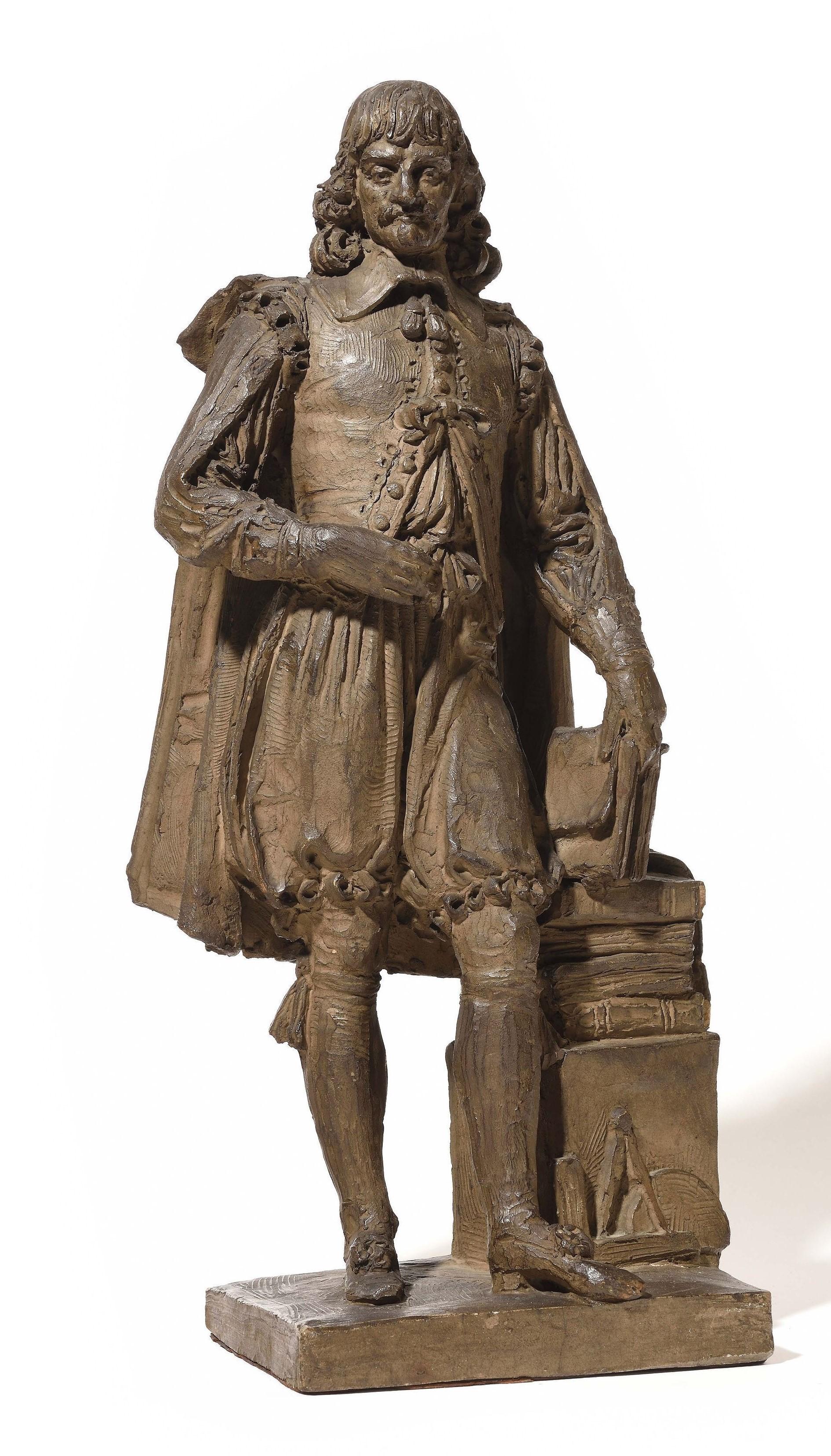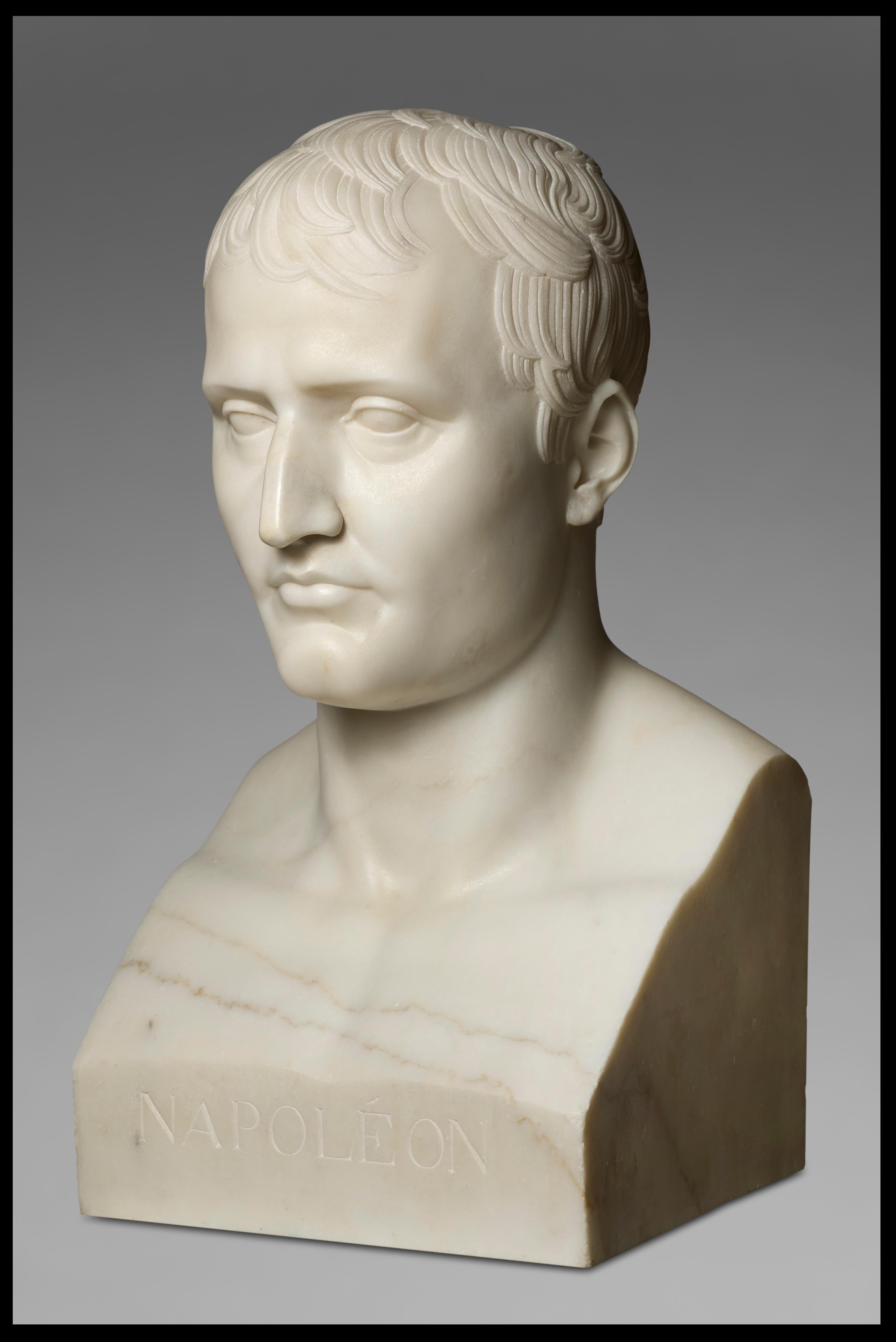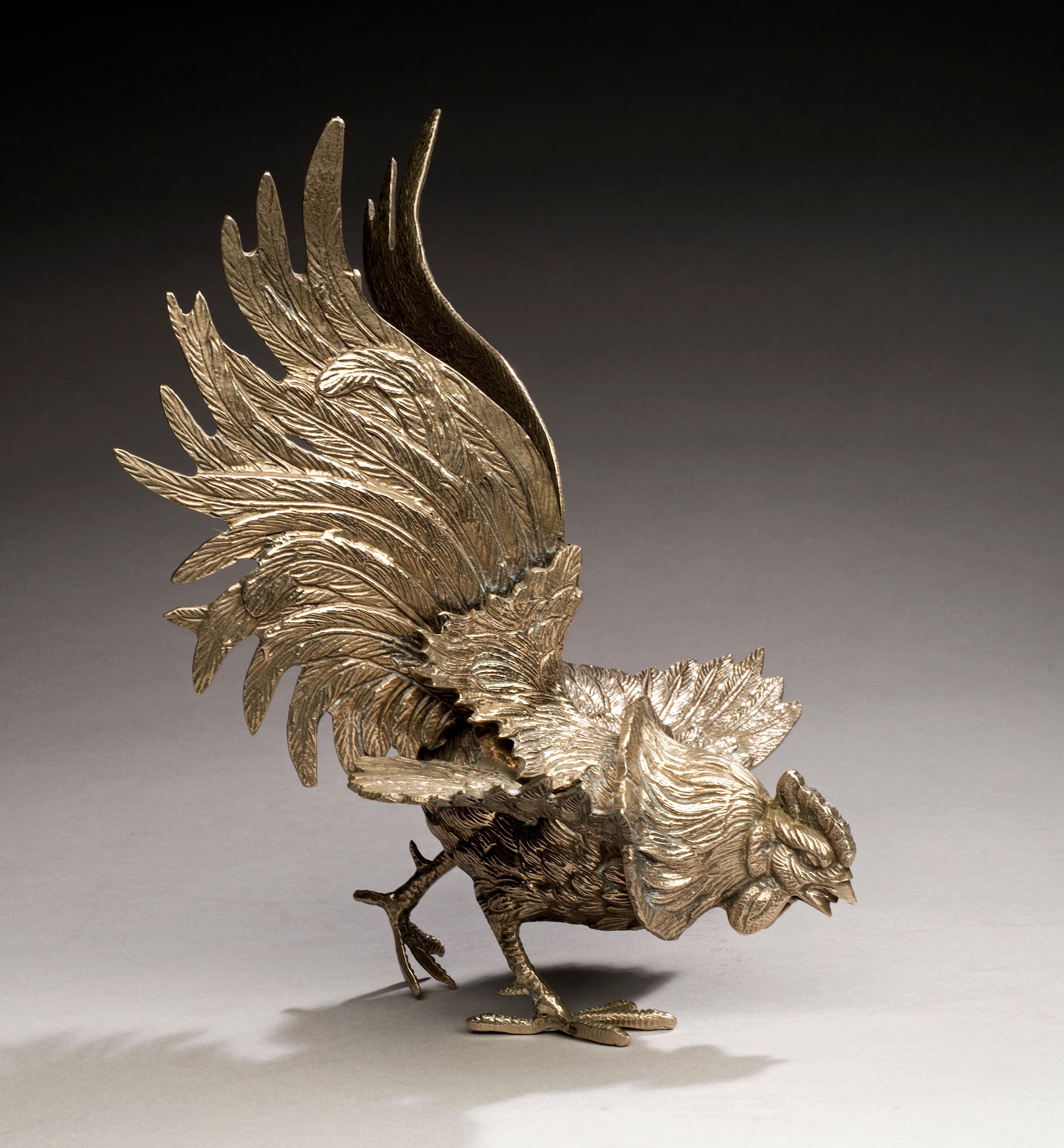Items Similar to General Cambronne bust in "Hermès" - Att. to E-E Suc (1802-1855)
Want more images or videos?
Request additional images or videos from the seller
1 of 5
General Cambronne bust in "Hermès" - Att. to E-E Suc (1802-1855)1842
1842
About the Item
Attributed to Etienne-Édouard SUC
(Lorient, 1802 – Nantes, 1855)
Bust "in Hermès" of General Cambronne
Plaster
H. 59 cm
1842
Provenance: probably Madame Cambronne (1773-1854), widow of the general
Our bust of General Cambronne (1770-1842) could be an interesting rediscovery of a work by the Breton sculptor Etienne-Édouard Suc.
Renowned for his bravery, demonstrated during the revolutionary wars and then during the battles of the Empire and in particular the campaigns in Russia and France, Cambronne had acquired great celebrity at Waterloo, where he heroically commanded the last square of the Imperial Guard. Seriously wounded on this occasion and taken prisoner, he was treated in England by a Scottish nurse, whom he married in 1820. Returning to France at the beginning of December 1815, he was tried in Paris by the new monarchical regime for treason but benefited from a acquittal on April 26, 1816 and returned to his native city of Nantes on May 9, 1816.
His known sculpted effigies, made in the first half of the 19th century, are limited to those of the Debay father and son.
Jean-Baptiste-Joseph Debay (1779-1863), said the father, originally from Mâlines, pupil of Chaudet and living in Nantes since 1801, had, as we can read in the magazine L'Artiste of 1842, "started a bust of this brave general, immediately after the outcome of the trial (therefore in 1816) ... strikingly resembling", The Artist mentioning at the same time 1815 as the date of the beginning of the work ... It is only 'at the Salon of 1853 that the sculptor presented a plaster bust (N°1299), General Cambronne from nature in 1816, followed at the Salon of 1855 by the marble version (N°4323) acquired by Napoleon III; the plaster bust of 1853 was purchased by the State to be placed in Versailles, but there are other posthumous copies in the Royal Museums of Fine Arts of Belgium and the town hall of Mâlines. This bust represents the general in uniform, in an attitude that is both solemn and very dynamic.
This date of 1815 is again indicated by Jean-Baptiste-Joseph Debay (1802-1862), known as the son, when, in order to obtain the order for the statue decided by the city of Nantes in 1842 just after the death of General , put forward the following argument: "I have for the resemblance of the statue a guarantee that no one else can now offer. My father made in 1815 after General Cambronne who came to pose at his home, a bust marked of a striking resemblance and of that beautiful character which my father knows so well how to put into his sculpture... the only portrait made during the lifetime of the general... this bust, my father abandons it to me". This date of 1815 seems to pose a problem, since Cambronne is at the beginning of the year on the island of Elba (he is the military commander), then it is the Waterloo campaign in June, the convalescence in England in the second half , and the return to Paris in December... Would he then have returned to Nantes for a few days between April and June to pose for Debay senior? If his detailed biography (Cambronne; his civil, political and military life by Léon Brunschvicg, 1894) does not mention it (there is, however, a source recounting a day in May when he set out to kiss his elderly mother), it indicates, however, that the bust was probably made during the few weeks that Cambronne spent in Paris in the spring of 1815, thus implying Debay's visit to Paris...
Be that as it may, the (full-length) statue of Debay junior, which was inaugurated in Nantes in July 1848, was strongly inspired by that of his father as far as the face is concerned: the same severe air, fiery hair styled in the identical, favorites very provided. Note that there is a bronze bust (Inv.14.1.9.S), with a presentation in Hermès like ours, signed J. Debay, and acquired in 2013 by the Musée d'Arts de Nantes, of which it is difficult to decide on the paternity between the father and the son.
Concerning our bust, the identity of Cambronne is beyond doubt, if only by the skin growth present on the left cheekbone.
Concerning its author, there are similarities with the effigies of Debay, in particular in the broad treatment of the curls of the hair, and one could think of a first thought, "in the Antique", of Debay father, for his bust of 1816 , before he chose to give it a more contemporary military appearance. However, the much more subdued physiognomy, the less vigorous hair (Cambronne had however kept his curls until his death), the less dense sideburns, and especially the more "heavy" chin and neck, lead us to favor an effigy more Late Cambronne, and by another artist.
However, the biography of Brunschvicg tells us that, in the inventory of the furniture of the widow (who died on January 4, 1854) from Cambronne, there was a bust of the general by Suc, a bust executed in 1842, "from a cast taken on the face of the general. The family did not find him very similar", without e the material (plaster or terracotta) of this bust is specified. Suc was one of the Nantes sculptors who proposed their candidacy for the statue that the city had decided to make only a week after the death of its local glory; he had been able, with Mrs. Cambronne's authorization, to "access" the remains to take a cast, the basis for a bust. Suc said he was "appointed by the family of the illustrious general, to revive his features". But the family, skeptical about the resemblance, asked another Nantes sculptor, Amédée Renard (1806-1879), a pupil of Mahlknecht, to create a terracotta bust (which was still in the family of the adopted daughter of Cambronne). And we have seen that it was finally Debay junior who won the order of the city.
It is quite likely that our bust is the one sculpted by Suc in 1842 and having belonged to the widow of Cambronne. Born in Lorient, pupil in Paris of Henri Lemaire from 1828, Suc exhibited for the first time at the Salon in 1834 and obtained a gold medal there in 1838. He produced a few sculpted genre or religious groups, but he was truly specialized in the portraits, with numerous medallions, but above all a very large quantity of busts, in particular of soldiers (Generals Belliard and Dumoustier, Drouet d'Erlon for example), with a predilection for so-called "Hermès" representations. Steeped in a neoclassical background, his art drew much from ancient tradition, according to an obituary in the 1854 Western Provinces Review.
- Attributed to:Etienne-Edouard Suc (1802 - 1855, French)
- Creation Year:1842
- Dimensions:Height: 23.23 in (59 cm)Width: 15.75 in (40 cm)
- Medium:
- Movement & Style:
- Period:
- Condition:
- Gallery Location:BELEYMAS, FR
- Reference Number:1stDibs: LU1860210111132
About the Seller
No Reviews Yet
Vetted Seller
These experienced sellers undergo a comprehensive evaluation by our team of in-house experts.
Established in 2011
1stDibs seller since 2022
- ShippingRetrieving quote...Ships From: BELEYMAS, France
- Return PolicyThis item cannot be returned.
More From This SellerView All
- Dominique Mahlknecht (1793-1876) The french philosopher René DescartesLocated in BELEYMAS, FRDominique (Johann Dominik) MAHLKNECHT (Kastelruth, 1793 - Paris, 1876) Full length portrait of René Descartes Terracotta with brown patina Height: 40cm ...Category
1840s French School Figurative Sculptures
MaterialsPlaster
- Maurice Lobre (1862 -1951) The snackBy Maurice LobreLocated in BELEYMAS, FRMaurice LOBRE (Bordeaux 1862 - Paris 1951) Le goûter Huile sur toile H. 87 cm ; L. 91,5 cm Format peint d’origine, H. 101 cm ; L. 96 cm, disposé sur un châssis plus petit par l’artiste lui-même. Signée et datée 1888 en bas à droite Provenance : Collection privée, Lyon Exposition : 1889, Salon des Artistes Français, n°1719 « Intérieur », (ou 1720 nommé également « Intérieur ») Œuvres en rapport : Le Cabinet de toilette de Jacques-Emile Blanche, (titre erroné) H. 80 cm ; L. 85 cm, HST, Museo Thyssen-Bornemisza, Madrid, pendant de notre toile. Maurice Lobre a-t-il connu Marcel Proust ? On ne peut encore l'affirmer, bien qu'il ait eu de nombreux amis en commun avec l'écrivain. Mais sa peinture intimiste pourrait illustrer certaines pages de Du côté de chez Swann. Trois citations dues à des proches de Proust, l'une de l'écrivain Léon Daudet, la seconde du peintre Jacques-Emile Blanche, la dernière du poète mondain Robert de Montesquiou, donnent un aperçu de ce que fut la renommée de Maurice Lobre en son temps : "Il en va autrement de Lobre, le Vermeer français, le peintre exquis des intérieurs et des palais de Versailles, des reflets sur les meubles rares, de la lumière prisonnière des miroirs, des laques et des cuivres polis. Lobre est joyeux comme un coup de vent, qui fait envoler les préjugés et les poncifs, éloquent, passionné, ivre de la couleur et des formes, charmant et conquérant de toutes les matières. Il se promène ici-bas ainsi que dans un musée en plein-air, s'amuse de tout, rejette et maudit le laid et le vil, accueille et bénit le beau et le bien…" Léon Daudet L'Entre-deux-guerres. Souvenirs des milieux littéraires, politiques, artistiques et médicaux de 1880 à 1905. "Voici le patient, appliqué, sage M. Lobre. Il est difficile de mettre plus d'honnêteté à peindre des intérieurs sans figures. Je préfère ses petits salons de Versailles à ses cathédrales… Nous lui devons des petits bijoux d'émotion et de large fini." Jacques-Emile Blanche "Il a recueilli sur des toiles le visage du vieux Versailles (…). Il a peuplé de visions impalpables des chambres " où il s'est passé quelque chose ", et il en a saturé l'atmosphère de particules historiques. Donner une telle impression avec certitude, avec vérité, c'est plus difficile que de faire évoluer des personnages costumés, dans ce qu'on appelle bêtement "une reconstitution historique"." Comte Robert de Montesquiou Maurice Lobre commence sa carrière au Salon de 1882 où il expose deux portraits, dont celui de son camarade de l'atelier Carolus-Duran, le peintre espagnol Ramon Casas...Category
1880s French School Figurative Paintings
MaterialsCanvas, Oil
- Portrait of a man in armorLocated in BELEYMAS, FRAttributed to Jacques DUMONT aka DUMONT LE ROMAIN (Paris 1701 - 1781) Presumed portrait of Louis-Joseph de Formanoir (?-1732) Oil on canvas H. 91.5 cm; ...Category
1750s French School Figurative Paintings
MaterialsCanvas, Oil
- Lake Albano, Castel Gandolfo ItalyBy Antoine Ponthus-CinierLocated in BELEYMAS, FRAntoine-Claude PONTHUS-CINIER (Lyon, 1812 - Lyon, 1885) Lake Albano, Castel Gandolfo and the Roman countryside Oil on canvas mounted on cardboard H. 38 cm; L. 55 cm Signed lower left Ponthus-Cinier belongs to what could be defined as the third (and so to speak last) generation of neo-classical or historical landscape painters, born in the years 1810/1820, like Félix Lanoüe, Achille Bénouville...Category
1840s French School Figurative Paintings
MaterialsCanvas, Oil
- Model undressingLocated in BELEYMAS, FRJulius EXNER (Copenhagen, 1825 - Copenhagen, 1910) Model stripping Oil on canvas H. 122 cm; L. 74 cm Signed and dated 1842 lower right Exhibition: most likely Charlottenborg Salon of 1845, under number 110, titled Modelfigur, awarded with a silver medal Provenance: Emilio Fernando Bolt (c.1860 - 1944), acquired from the artist around 1900, then by descent Our painting was produced as part of the summer sessions organized between 1839 and 1850 by Christoffer Wilhelm Eckersberg (1783-1853), the master of Danish painting of the first half of the 19th century, in his private studio-apartment on the ground floor. floor at the Royal Academy of Fine Arts in Copenhagen. The master brought together a few students there between June and September, rented one or two models for the season, which were painted from different angles, the artists (including Eckersberg himself) sitting side by side. Eckersberg used to paint a fairly small version, the pupils of the larger formats. The work fits more generally into the legendary context of the research and reforms carried out by Eckersberg concerning the studies of nudes and in particular of female nudes, to make this exercise a genre of painting in its own right. Following his two-year stint in Jacques-Louis David's studio in Paris in 1811, Eckersberg had been made aware of work on the nude and in particular on live models, in natural light, while in Denmark the drawings were then only made from casts of antique models or other mannequins. In 1822, when he had been a professor there since 1818, it was he who had the Royal Academy of Copenhagen authorize the study of nudes, no longer in the evening by candlelight, but in natural light; from 1833, it was still he who allowed students to work on nude female models, even if the official authorization of the Academy did not take place until 1839. It was this same year that he instituted his summer sessions, on a private basis, to orient his painting and that of his students towards a new conception of the representation of models: even if the nude remains the real theme, it does not however, this is more than just an academic exercise. The subject is placed in a contemporary interior, with a rather sophisticated decor, and occupied with an intimate activity (it is this type of intimate vein that we will find later in Degas or Cassatt for example); thus in our painting, the young woman is supposed to take off her clothes to wash. The objective is that the viewer forgets that the master and his students are painting a model during a posing session, and that he instead has the impression of being alone with the model, but invisible, almost like a voyeur in spite of himself. Moreover, in these paintings, the model never looks towards the spectator, inducing a psychological distance with him, whereas model and artist are actually physically very close. On the other hand, it is not a question of idealized nudes either, even if Eckersberg, proof of his debt to the antique, chooses fairly classic models and poses. The sensuality is real and very present, with dreamy, even innocent, and timeless expressions (the models do not seem to have a defined age), suave and slow attitudes and movements, and especially with clothes that hide or reveal skillfully parts of the female body: upper buttocks, pronounced hips... Made by an artist under 20, our sensual painting is probably one of the most beautiful and spectacular produced by the students of Eckersberg during these summer sessions. With a perfect balance between the firmness of an ancient statue (it recalls the Venus de Milo) and the softness of the feminine forms, highlighted by a harmonious palette, it captures the attention with many details: the almost photographic folds white clothing...Category
1840s French School Nude Paintings
MaterialsCanvas, Oil
- Workshop of Louis de Boullogne - Moses defending Jethro's daughtersLocated in BELEYMAS, FRWorkshop of Louis de BOULLOGNE (Paris 1654 – Paris 1733) Moses defending the daughters of Jethro Oil on canvas H. 75 cm; W. 106 cm Produced at the end of the 17th century, this fair...Category
17th Century French School Figurative Paintings
MaterialsOil, Canvas
You May Also Like
- Friendship, comfort: hand modelled sculpture by Polish Jewish French artistLocated in Norwich, GBAn extraordinary depiction of friendship and comfort by Polish Jewish sculptor Michal Michael Milberger. Milberger was born in Warsaw in 1922. His artis...Category
Late 20th Century French School Figurative Sculptures
MaterialsPlaster
- Napoleon IstLocated in Paris, FRAntoine-Denis CHAUDET (1763 - 1810) NAPOLEON Ist, circa 1808 Carrare Marble - First Empire Hermes Bust of Napoleon Ist, after Antoine-Denis CHAUDET Dimen...Category
Early 1800s French School Figurative Sculptures
MaterialsMarble
- Hay BinderBy Aimé-Jules DalouLocated in PARIS, FRThis Hay binder is a subject that is included in the famous suite commonly called "little workers" by Jules Dalou (1838-1902) Bronze with dark brown patina cast by Susse Frères - st...Category
Late 19th Century French School Figurative Sculptures
MaterialsBronze
- Antique Bronze Dog Portrait of a Cavalier King Charles "Thigley" circa 1905Located in SANTA FE, NMAntique Bronze Dog Portrait of a Cavalier King Charles "Thigley" French School (possibly Franck Burty Haviland) Lost wax bronze casting Circa 1910 5 7/8 x 9 x 3 1/4 A sophisticated bronze casting of a Cavalier King Charles spaniel made in lost wax casting (cire perdue) from the beginning of the 20th century by Valsuani Foundry. This an unusual bronze approached in its aesthetic that’s reminiscent of the work of great animal sculptors of the second half of the 19th century except in this presentation which is more avant-garde for the time with a much looser, more impressionistic execution. The patina is a superb bronze color, brown and slightly greenish, going in places towards a more antique green. The attitude of the dog is extremely well and sensitively rendered with the placement of material unlike the renderings of a bronze by Barye...Category
Early 1900s French School Figurative Sculptures
MaterialsBronze
- Antique Silvered Bronze Rooster, France circa 19th CenturyLocated in SANTA FE, NMAntique Silvered Bronze Rooster France, circa 1900 10 1/4 x 9 1/2 (H x D) inches A very fine and lively bronze statuette of a preening Rooster. Nicely cast and well-carved and in ex...Category
19th Century French School Figurative Sculptures
MaterialsSilver, Bronze
- Portrait of Prince ImpérialLocated in PARIS, FRPortrait of Prince Impérial Louis-Napoléon Bonaparte (1856-1879), son of Emperor Napoléon III by Prosper D'EPINAY (1836-1914) A rare and very fine portrait sculpted in white Carrara...Category
1880s French School Figurative Sculptures
MaterialsMarble
Recently Viewed
View AllMore Ways To Browse
The General
Antique Plaster Art
Large Plaster Cast
Bust General
Medallion Sculpture
Antique Still-life Sculptures
Hermes Museum
Dior Plaster
Portrait Bust Bronze
Hermes Paris Art
Neoclassic Large Sculptures
Antique Russian Sculpture
Ancient Plaster
Bust Antique England
Civil War Generals
Hermes Style Furnitures
Hermes Hall
The Kiss Sculpture




